Prenatal Exposure to Tobacco and Cannabis in Six Race/Ethnicity Groups during the First Three Years after Legalization of Cannabis for Recreational Use in California
Abstract
:1. Introduction
2. Materials and Methods
3. Results
4. Discussion
5. Conclusions
Supplementary Materials
Author Contributions
Funding
Institutional Review Board Statement
Informed Consent Statement
Data Availability Statement
Acknowledgments
Conflicts of Interest
References
- U.S. Department of Health and Human Services. The Health Consequences of Smoking: 50 Years of Progress. A Report of the Surgeon General; U.S. Department of Health and Human Services, Centers for Disease Control and Prevention, National Center for Chronic Disease Prevention and Health Promotion, Office on Smoking and Health: Atlanta, GA, USA, 2014.
- DiFranza, J.R.; Aligne, C.A.; Weitzman, M. Prenatal and postnatal environmental tobacco smoke exposure and children’s health. Pediatrics 2004, 113, 1007–1015. [Google Scholar] [CrossRef] [PubMed]
- Leonardi-Bee, J.; Britton, J.; Venn, A. Secondhand smoke and adverse fetal outcomes in nonsmoking pregnant women: A meta-analysis. Pediatrics 2011, 127, 734–741. [Google Scholar] [CrossRef] [PubMed]
- Accordini, S.; Calciano, L.; Johannessen, A.; Portas, L.; Benediktsdóttir, B.; Bertelsen, R.J.; Bråbäck, L.; Carsin, A.E.; Dharmage, S.C.; Dratva, J.; et al. A three-generation study on the association of tobacco smoking with asthma. Int. J. Epidemiol. 2018, 47, 1106–1117. [Google Scholar] [CrossRef] [PubMed]
- Ding, M.; Yuan, C.; Gaskins, A.J.; Field, A.E.; Missmer, S.A.; Michels, K.B.; Hu, F.; Zhang, C.; Gillman, M.W.; Chavarro, J. Smoking during pregnancy in relation to grandchild birth weight and BMI trajectories. PLoS ONE 2017, 12, e0179368. [Google Scholar] [CrossRef] [PubMed]
- Dietz, P.M.; England, L.J.; Shapiro-Mendoza, C.K.; Tong, V.T.; Farr, S.L.; Callaghan, W.M. Infant morbidity and mortality attributable to prenatal smoking in the U.S. Am. J. Prev. Med. 2010, 39, 45–52. [Google Scholar] [CrossRef]
- Kharrazi, M.; DeLorenze, G.N.; Kaufman, F.L.; Eskenazi, B.; Bernert, J.T., Jr.; Graham, S.; Pearl, M.; Pirkle, J. Environmental tobacco smoke and pregnancy outcome. Epidemiology 2004, 15, 660–670. [Google Scholar] [CrossRef]
- Lo, J.O.; Hedges, J.C.; Girardi, G. Impact of cannabinoids on pregnancy, reproductive health, and offspring outcomes. Am. J. Obstet. Gynecol. 2022, 227, 571–581. [Google Scholar] [CrossRef]
- Roncero, C.; Valriberas-Herrero, I.; Mezzatesta-Gava, M.; Villegas, J.L.; Aguilar, L.; Grau-López, L. Cannabis use during pregnancy and its relationship with fetal developmental outcomes and psychiatric disorders. A systematic review. Reprod. Health 2020, 17, 25. [Google Scholar] [CrossRef]
- Campbell, M.A.; Iyer, P.; Kaufman, F.; Kim, A.; Moran, F.; Niknam, Y.; Wu, L.; Sandy, M.S.; Zeise, L. Animal evidence considered in determination of cannabis smoke and Δ(9)-tetrahydrocannabinol as causing reproductive toxicity (developmental endpoint); Part I. Somatic development. Birth Defects Res. 2022, 114, 1143–1154. [Google Scholar] [CrossRef]
- Smith, A.; Kaufman, F.; Sandy, M.S.; Cardenas, A. Cannabis Exposure during Critical Windows of Development: Epigenetic and Molecular Pathways Implicated in Neuropsychiatric Disease. Curr. Environ. Health Rep. 2020, 7, 325–342. [Google Scholar] [CrossRef]
- Rompala, G.; Nomura, Y.; Hurd, Y.L. Maternal cannabis use is associated with suppression of immune gene networks in placenta and increased anxiety phenotypes in offspring. Proc. Natl. Acad. Sci. USA 2021, 118, e2106115118. [Google Scholar] [CrossRef] [PubMed]
- Zumbrun, E.E.; Sido, J.M.; Nagarkatti, P.S.; Nagarkatti, M. Epigenetic Regulation of Immunological Alterations Following Prenatal Exposure to Marijuana Cannabinoids and its Long Term Consequences in Offspring. J. Neuroimmune Pharmacol. 2015, 10, 245–254. [Google Scholar] [CrossRef] [PubMed]
- Williams, L.J.; Correa, A.; Rasmussen, S. Maternal lifestyle factors and risk for ventricular septal defects. Birth Defects Res. A Clin. Mol. Teratol. 2004, 70, 59–64. [Google Scholar] [CrossRef] [PubMed]
- Dewey, W.L. Cannabinoid pharmacology. Pharmacol. Rev. 1986, 38, 151–178. [Google Scholar] [CrossRef]
- Pertwee, R.G. The diverse CB1 and CB2 receptor pharmacology of three plant cannabinoids: Delta9-tetrahydrocannabinol, cannabidiol and delta9-tetrahydrocannabivarin. Br. J. Pharmacol. 2008, 153, 199–215. [Google Scholar] [CrossRef]
- Pamplona, F.A.; Takahashi, R.N. Psychopharmacology of the endocannabinoids: Far beyond anandamide. J. Psychopharmacol. 2012, 26, 7–22. [Google Scholar] [CrossRef] [PubMed]
- California Legislature. Medicinal and Adult-Use Cannabis Regulation and Safety Act; California NORML: San Francisco, CA, USA, 2018.
- Office of Environmental Health Hazard Assessment Reproductive and Cancer Hazard Assessment Branch. Proposition 65: Evidence on the Developmental Toxicity of Cannabis (Marijuana) Smoke and Δ9-THC; OEHHA: Oakland, CA, USA, 2019.
- Martin, J.A.; Osterman, M.J.K.; Driscoll, A.K. Declines in Cigarette Smoking During Pregnancy in the United States, 2016–2021. NCHS Data Brief 2023, 458, 1–8. [Google Scholar]
- Ko, J.Y.; Coy, K.C.; Haight, S.C.; Haegerich, T.M.; Williams, L.; Cox, S.; Njai, R.; Grant, A.M. Characteristics of Marijuana Use During Pregnancy—Eight States, Pregnancy Risk Assessment Monitoring System, 2017. MMWR Morb. Mortal. Wkly. Rep. 2020, 69, 1058–1063. [Google Scholar] [CrossRef]
- Cornelius, M.E.; Loretan, C.G.; Wang, T.W.; Jamal, A.; Homa, D.M. Tobacco Product Use Among Adults—United States, 2020. MMWR Morb. Mortal. Wkly. Rep. 2022, 71, 397–405. [Google Scholar] [CrossRef]
- Center for Disease Control and Prevention. Prevalence of Selected Maternal and Child Health Indicators for All Pregnancy Risk Assessment Monitoring System (PRAMS) Sites, 2016–2020; Center for Disease Control and Prevention: Atlanta, GA, USA, 2020.
- Jarrell, Z.R.; Smith, M.R.; He, X.; Orr, M.; Jones, D.P.; Go, Y.M. Firsthand and Secondhand Exposure Levels of Maltol-Flavored Electronic Nicotine Delivery System Vapors Disrupt Amino Acid Metabolism. Toxicol. Sci. 2021, 182, 70–81. [Google Scholar] [CrossRef]
- Volkow, N.D.; Han, B.; Compton, W.M.; McCance-Katz, E.F. Self-reported Medical and Nonmedical Cannabis Use Among Pregnant Women in the United States. JAMA 2019, 322, 167–169. [Google Scholar] [CrossRef] [PubMed]
- Chu, A.; Chaiton, M.; Kaufman, P.; Goodwin, R.D.; Lin, J.; Hindocha, C.; Goodman, S.; Hammond, D. Co-Use, Simultaneous Use, and Mixing of Cannabis and Tobacco: A Cross-National Comparison of Canada and the US by Cannabis Administration Type. Int. J. Environ. Res. Public Health 2023, 20, 4206. [Google Scholar] [CrossRef] [PubMed]
- El Marroun, H.; Hudziak, J.J.; Tiemeier, H.; Creemers, H.; Steegers, E.A.; Jaddoe, V.W.; Hofman, A.; Verhulst, F.C.; van den Brink, W.; Huizink, A.C. Intrauterine cannabis exposure leads to more aggressive behavior and attention problems in 18-month-old girls. Drug Alcohol Depend. 2011, 118, 470–474. [Google Scholar] [CrossRef] [PubMed]
- Brown, Q.L.; Sarvet, A.L.; Shmulewitz, D.; Martins, S.S.; Wall, M.M.; Hasin, D.S. Trends in Marijuana Use Among Pregnant and Nonpregnant Reproductive-Aged Women, 2002–2014. JAMA 2017, 317, 207–209. [Google Scholar] [CrossRef] [PubMed]
- Obisesan, O.H.; Osei, A.D.; Uddin, S.M.I.; Dzaye, O.; Cainzos-Achirica, M.; Mirbolouk, M.; Orimoloye, O.A.; Sharma, G.; Al Rifai, M.; Stokes, A.; et al. E-Cigarette Use Patterns and High-Risk Behaviors in Pregnancy: Behavioral Risk Factor Surveillance System, 2016–2018. Am. J. Prev. Med. 2020, 59, 187–195. [Google Scholar] [CrossRef] [PubMed]
- Drake, P.; Driscoll, A.K.; Mathews, T.J. Cigarette Smoking During Pregnancy: United States, 2016. NCHS Data Brief 2018, 305, 1–8. [Google Scholar]
- Salas-Wright, C.P.; Vaughn, M.G.; Oh, S. Commentary on Allen et al. (2020): Cannabis use during pregnancy-the importance of a life-course health disparities framework. Addiction 2020, 115, 1717–1718. [Google Scholar] [CrossRef]
- England, L.; Tong, V.T.; Rockhill, K.; Hsia, J.; McAfee, T.; Patel, D.; Rupp, K.; Conrey, E.J.; Valdivieso, C.; Davis, K.C. Evaluation of a federally funded mass media campaign and smoking cessation in pregnant women: A population-based study in three states. BMJ Open 2017, 7, e016826. [Google Scholar] [CrossRef]
- Guerby, P.; Garabedian, C.; Berveiller, P.; Legendre, G.; Grangé, G.; Berlin, I. Tobacco and Nicotine Cessation During Pregnancy. Obstet. Gynecol. 2020, 136, 428–429. [Google Scholar] [CrossRef]
- Agency for Healthcare Research and Quality. Research Protocol: Smoking Cessation Interventions During Pregnancy and the Postpartum Period; Agency for Healthcare Research and Quality: Rockville, MD, USA, 2013.
- Stead, L.F.; Carroll, A.J.; Lancaster, T. Group behaviour therapy programmes for smoking cessation. Cochrane Database Syst. Rev. 2017, 3, Cd001007. [Google Scholar] [CrossRef]
- Ghorai, K.; Akter, S.; Khatun, F.; Ray, P. mHealth for Smoking Cessation Programs: A Systematic Review. J. Pers. Med. 2014, 4, 412–423. [Google Scholar] [CrossRef] [PubMed]
- ObG Project. ACOG Recommendations on Marijuana Use During Pregnancy and Lactation. Available online: https://www.obgproject.com/2023/01/23/acog-recommendations-on-marijuana-use-during-pregnancy-and-lactation/ (accessed on 31 August 2023).
- Martin, J.A.; Hamilton, B.E.; Osterman, M.J.K.; Driscoll, A.K. Births: Final Data for 2018. Natl. Vital Stat. Rep. 2019, 68, 1–47. [Google Scholar] [PubMed]
- Young-Wolff, K.C.; Tucker, L.Y.; Alexeeff, S.; Armstrong, M.A.; Conway, A.; Weisner, C.; Goler, N. Trends in Self-reported and Biochemically Tested Marijuana Use Among Pregnant Females in California From 2009–2016. JAMA 2017, 318, 2490–2491. [Google Scholar] [CrossRef] [PubMed]
- Delgado-Rodríguez, M.; Llorca, J. Bias. J. Epidemiol. Community Health 2004, 58, 635–641. [Google Scholar] [CrossRef] [PubMed]
- Hoshiko, S.; Pearl, M.; Yang, J.; Aldous, K.M.; Roeseler, A.; Dominguez, M.E.; Smith, D.; DeLorenze, G.N.; Kharrazi, M. Differences in Prenatal Tobacco Exposure Patterns among 13 Race/Ethnic Groups in California. Int. J. Environ. Res. Public Health 2019, 16, 458. [Google Scholar] [CrossRef] [PubMed]
- Graham, S.; California Department of Public Health, Genetic Disease Screening Program, Richmond, CA, USA. Personal Communication, 2023.
- Benowitz, N.L.; Bernert, J.T.; Caraballo, R.S.; Holiday, D.B.; Wang, J. Optimal serum cotinine levels for distinguishing cigarette smokers and nonsmokers within different racial/ethnic groups in the United States between 1999 and 2004. Am. J. Epidemiol. 2009, 169, 236–248. [Google Scholar] [CrossRef] [PubMed]
- Azenkot, T.; Dove, M.S.; Fan, C.; Valencia, C.V.; Tong, E.K.; Schwarz, E.B. Tobacco and Cannabis Use During and After Pregnancy in California. Matern. Child Health J. 2023, 27, 21–28. [Google Scholar] [CrossRef] [PubMed]
- Maternal Child and Adolescent Health Division of the California Department of Public Health. Maternal and Infant Health Assessment (MIHA) Survey, 2018–2020; CDPH: Sacramento, CA, USA, 2023.
- Young-Wolff, K.C.; Adams, S.R.; Padon, A.; Silver, L.D.; Alexeeff, S.E.; Van Den Eeden, S.K.; Avalos, L.A. Association of Cannabis Retailer Proximity and Density With Cannabis Use Among Pregnant Women in Northern California After Legalization of Cannabis for Recreational Use. JAMA Netw. Open 2021, 4, e210694. [Google Scholar] [CrossRef]
- Davis, A.C.; Voelkel, J.L.; Remmers, C.L.; Adams, J.L.; McGlynn, E.A. Comparing Kaiser Permanente Members to the General Population: Implications for Generalizability of Research. Perm. J. 2023, 27, 87–98. [Google Scholar] [CrossRef]
- Hayes, S.; Delker, E.; Bandoli, G. The prevalence of cannabis use reported among pregnant individuals in the United States is increasing, 2002–2020. J. Perinatol. 2023, 43, 387–389. [Google Scholar] [CrossRef]
- Schauer, G.L.; Tynan, M.A.; Marynak, K. Self-reported exposure to, perceptions about, and attitudes about public marijuana smoking among US adults, 2018. Addiction 2020, 115, 1320–1329. [Google Scholar] [CrossRef] [PubMed]
- van Gelder, M.M.; Reefhuis, J.; Caton, A.R.; Werler, M.M.; Druschel, C.M.; Roeleveld, N. Characteristics of pregnant illicit drug users and associations between cannabis use and perinatal outcome in a population-based study. Drug Alcohol Depend. 2010, 109, 243–247. [Google Scholar] [CrossRef] [PubMed]
- Mark, K.; Desai, A.; Terplan, M. Marijuana use and pregnancy: Prevalence, associated characteristics, and birth outcomes. Arch. Womens Ment. Health 2016, 19, 105–111. [Google Scholar] [CrossRef] [PubMed]
- Young-Wolff, K.C.; Sarovar, V.; Tucker, L.Y.; Ansley, D.; Goler, N.; Conway, A.; Ettenger, A.; Foti, T.R.; Brown, Q.L.; Kurtzman, E.T.; et al. Trends in Cannabis Polysubstance Use During Early Pregnancy Among Patients in a Large Health Care System in Northern California. JAMA Netw. Open 2022, 5, e2215418. [Google Scholar] [CrossRef]
- Vachhani, K.; Simpson, A.N.; Wijeysundera, D.N.; Clarke, H.; Ladha, K.S. Cannabis use among pregnant women under different legalization frameworks in the United States. Am. J. Drug Alcohol Abuse 2022, 48, 695–700. [Google Scholar] [CrossRef]
- Manthey, J.; Jacobsen, B.; Hayer, T.; Kalke, J.; López-Pelayo, H.; Pons-Cabrera, M.T.; Verthein, U.; Rosenkranz, M. The impact of legal cannabis availability on cannabis use and health outcomes: A systematic review. Int. J. Drug Policy 2023, 116, 104039. [Google Scholar] [CrossRef]
- Benowitz, N.L.; Jacob, P., 3rd. Metabolism of nicotine to cotinine studied by a dual stable isotope method. Clin. Pharmacol. Ther. 1994, 56, 483–493. [Google Scholar] [CrossRef]
- Grotenhermen, F. Pharmacokinetics and pharmacodynamics of cannabinoids. Clin. Pharmacokinet. 2003, 42, 327–360. [Google Scholar] [CrossRef]
- Bernert, J.T., Jr.; Turner, W.E.; Pirkle, J.L.; Sosnoff, C.S.; Akins, J.R.; Waldrep, M.K.; Ann, Q.; Covey, T.R.; Whitfield, W.E.; Gunter, E.W.; et al. Development and validation of sensitive method for determination of serum cotinine in smokers and nonsmokers by liquid chromatography/atmospheric pressure ionization tandem mass spectrometry. Clin. Chem. 1997, 43, 2281–2291. [Google Scholar] [CrossRef]
- Bernert, J.T.; Jacob, P., 3rd; Holiday, D.B.; Benowitz, N.L.; Sosnoff, C.S.; Doig, M.V.; Feyerabend, C.; Aldous, K.M.; Sharifi, M.; Kellogg, M.D.; et al. Interlaboratory comparability of serum cotinine measurements at smoker and nonsmoker concentration levels: A round-robin study. Nicotine Tob. Res. 2009, 11, 1458–1466. [Google Scholar] [CrossRef]

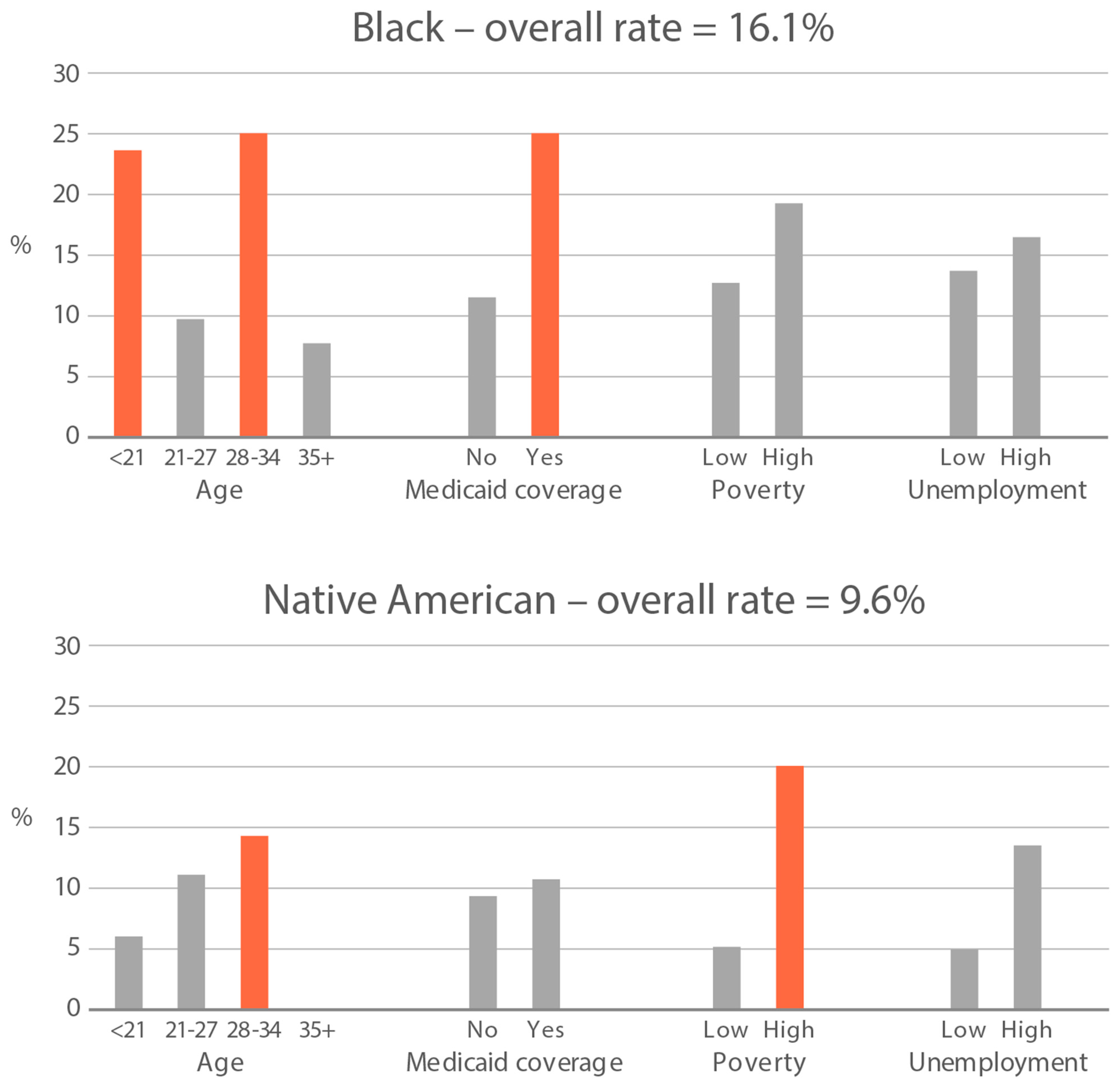
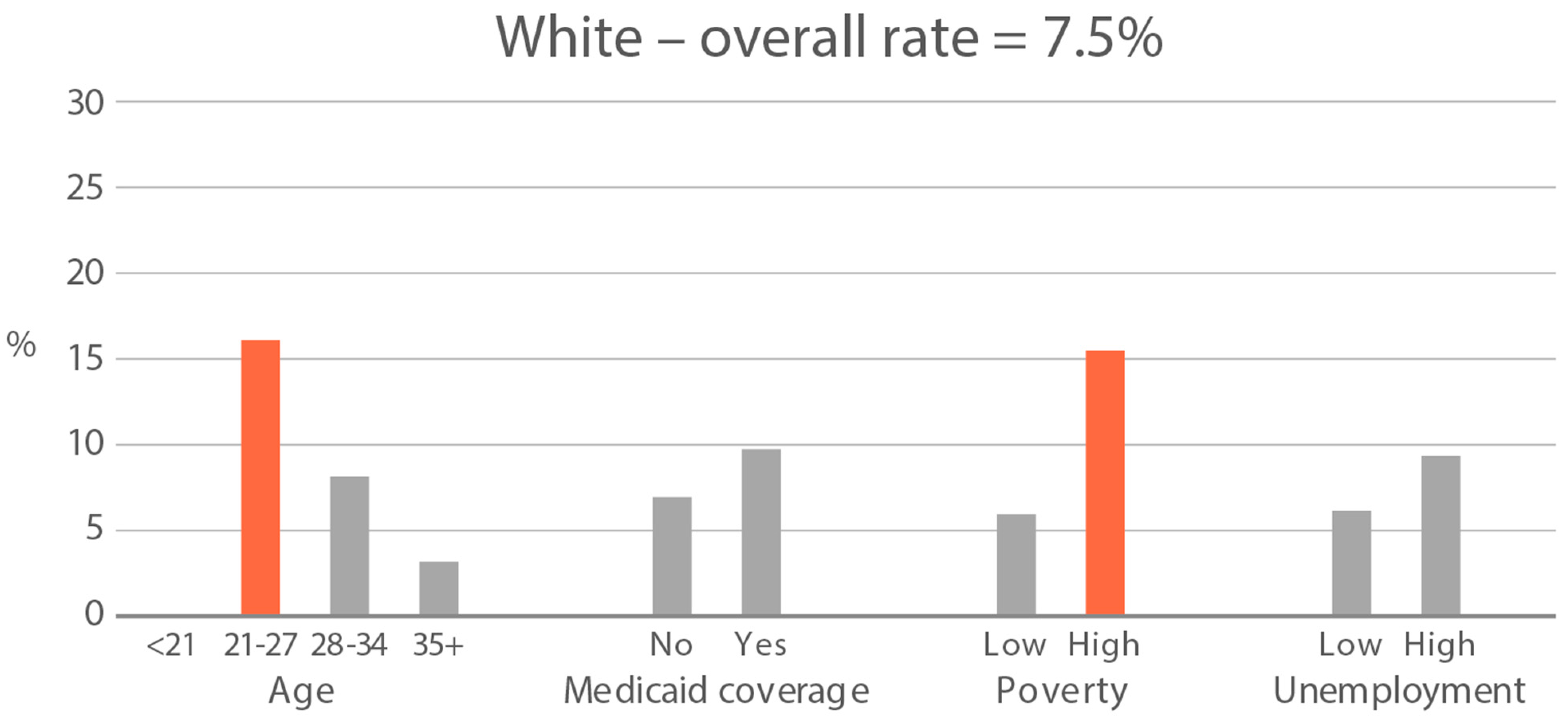
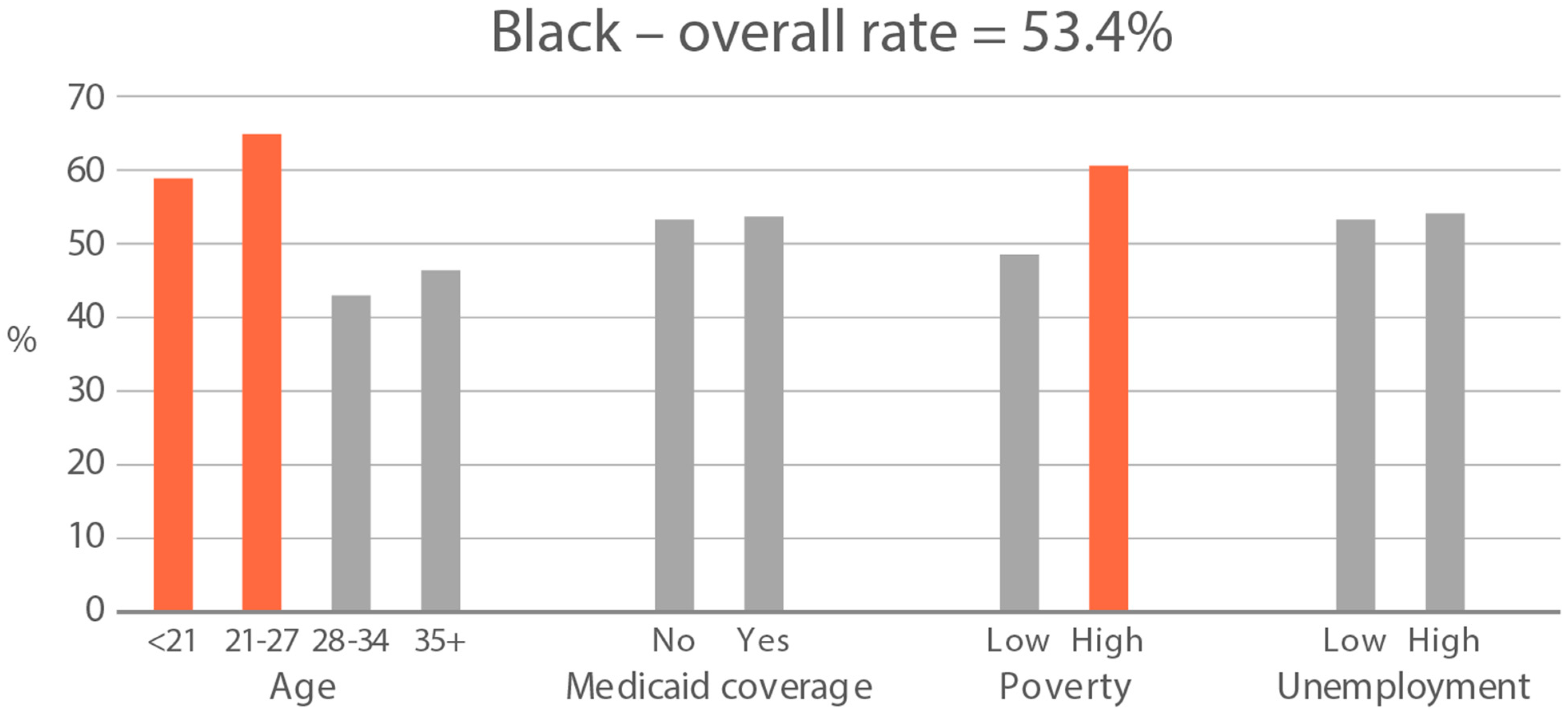
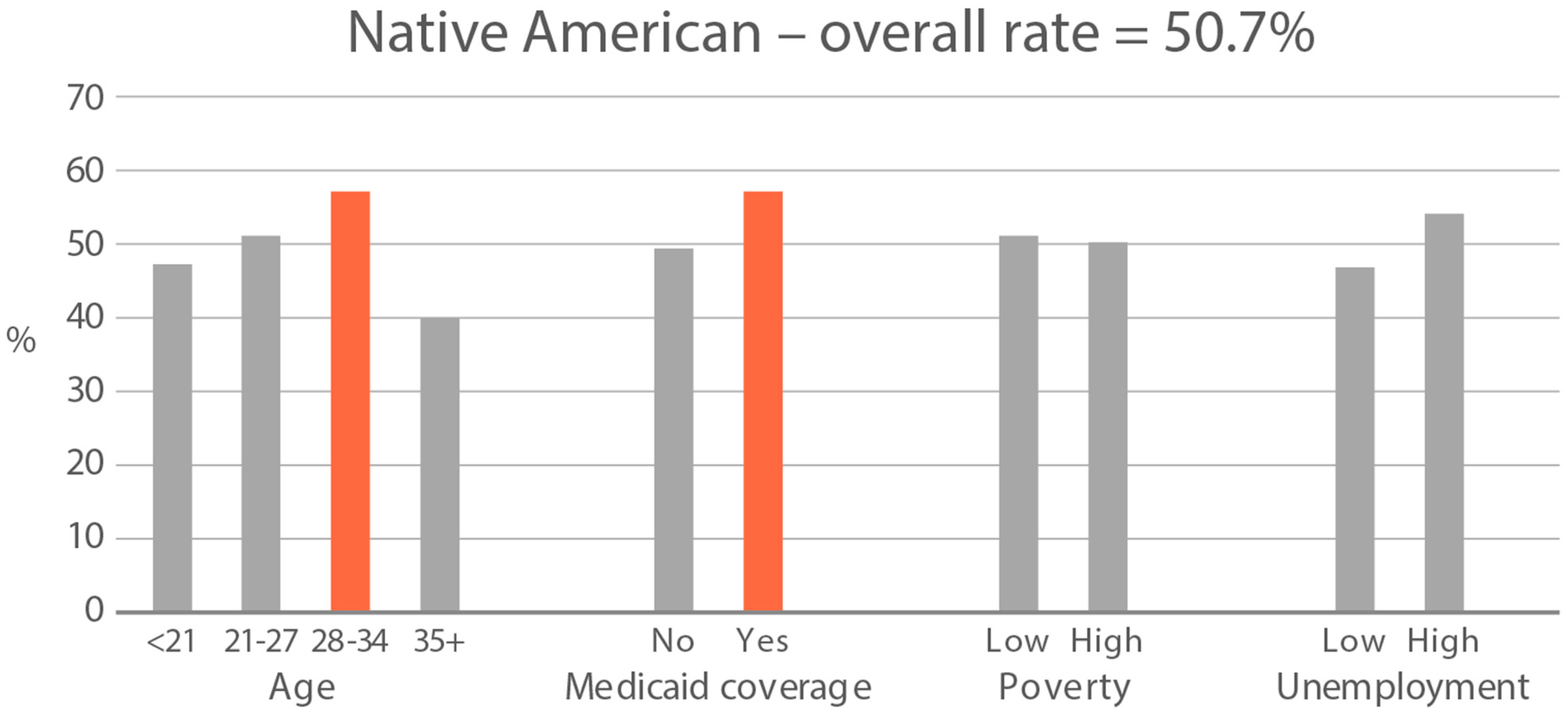
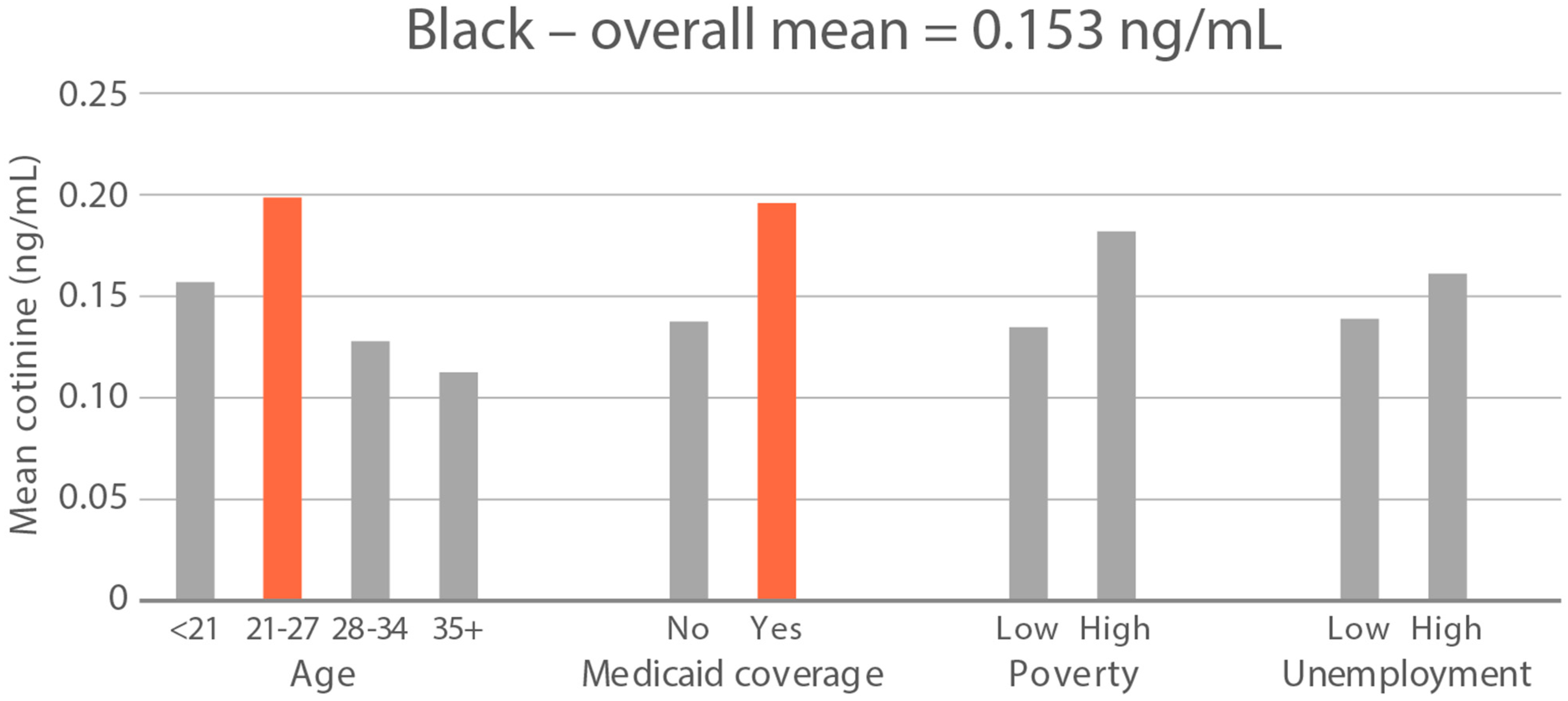
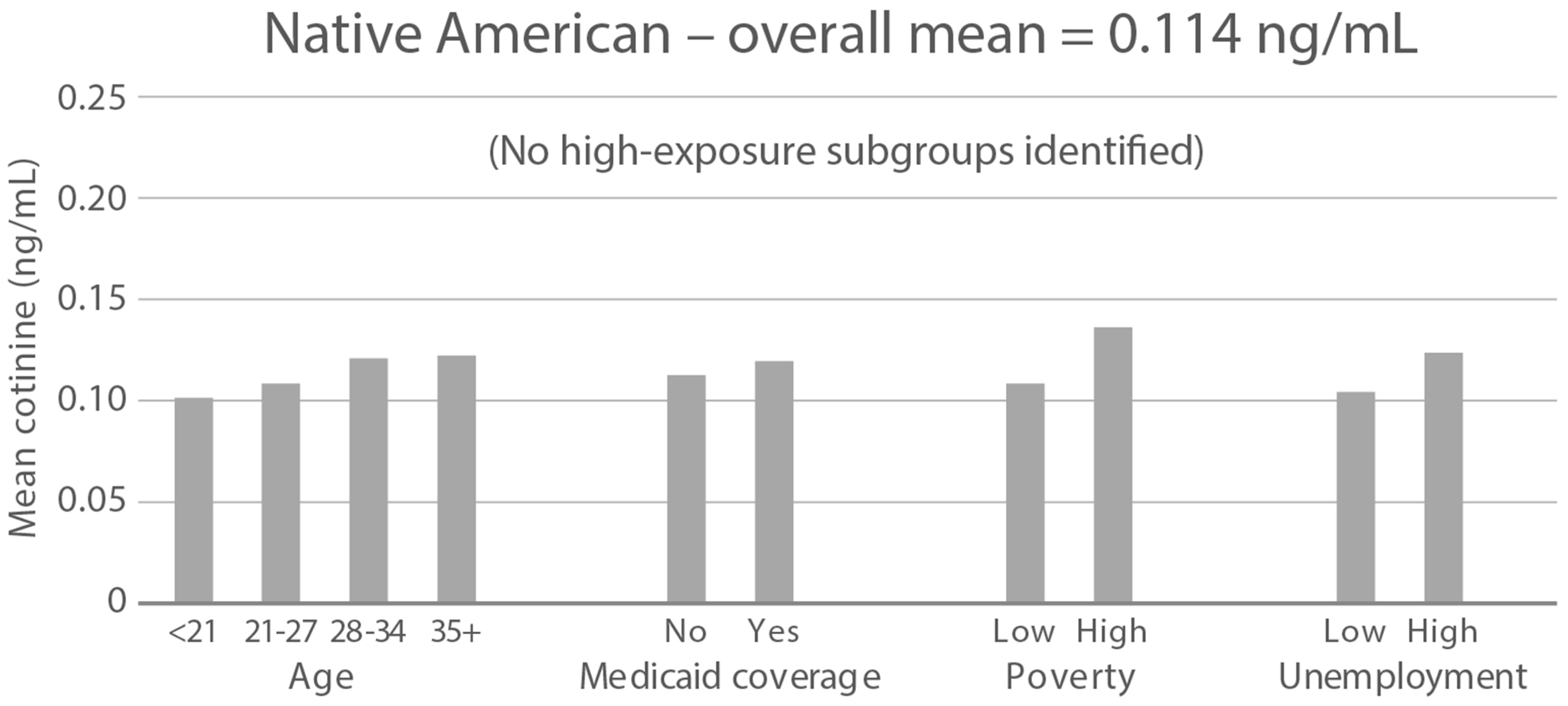
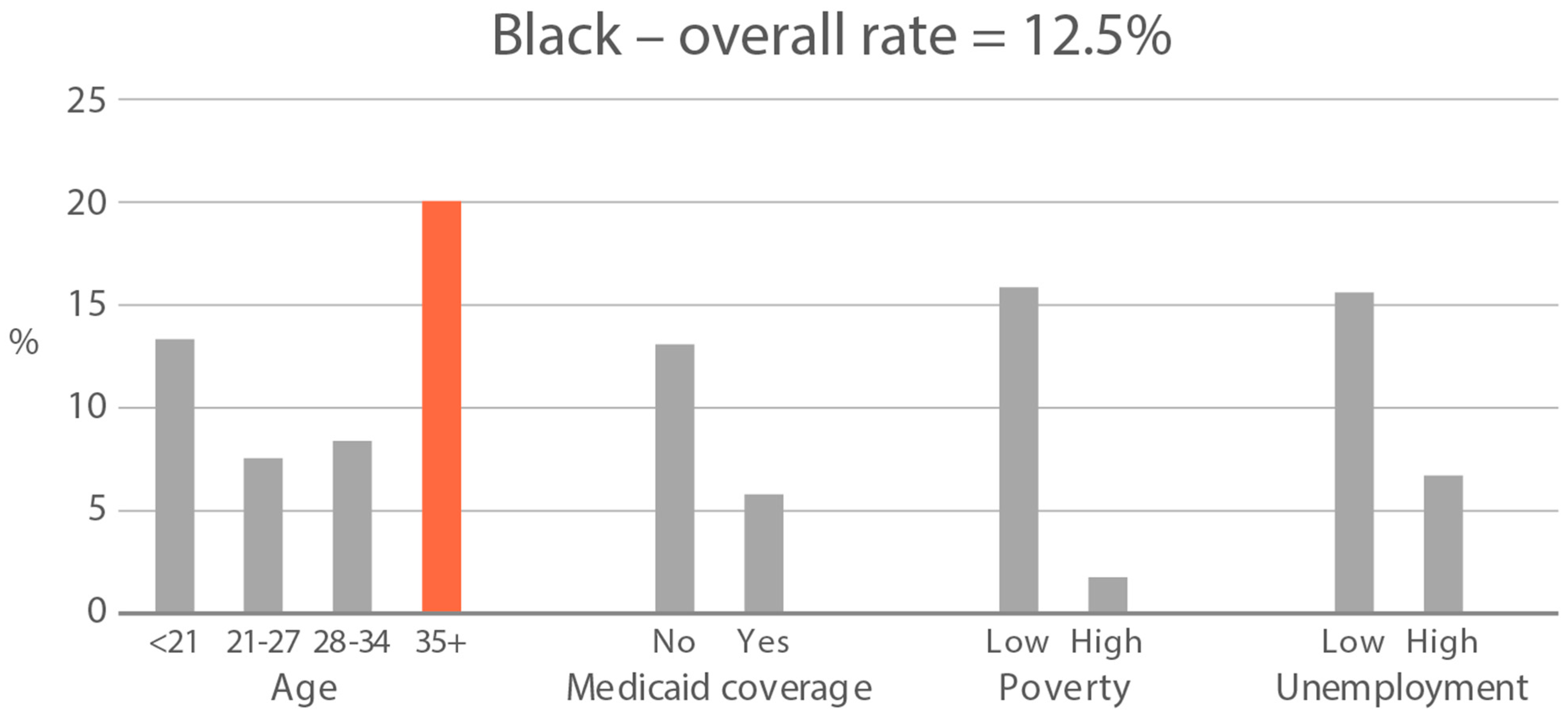

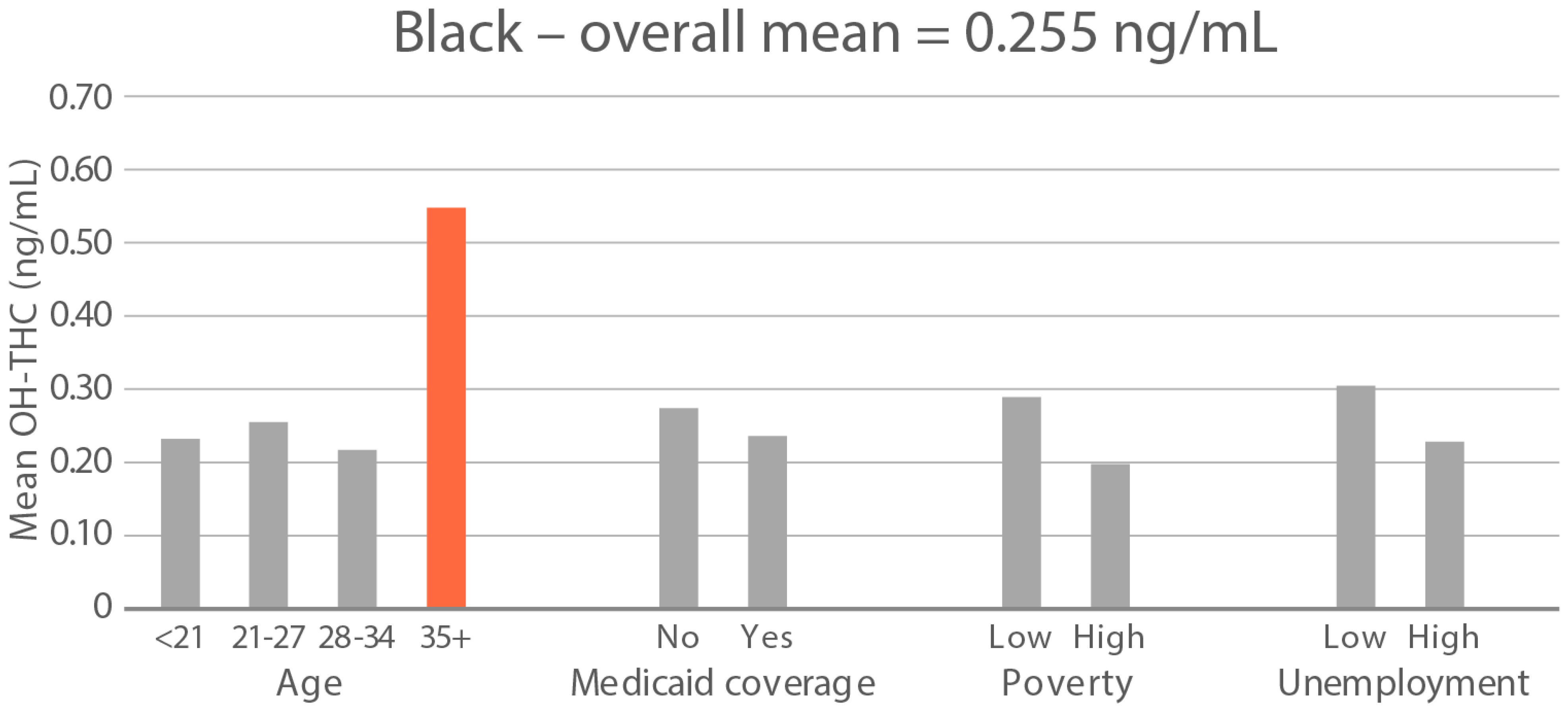

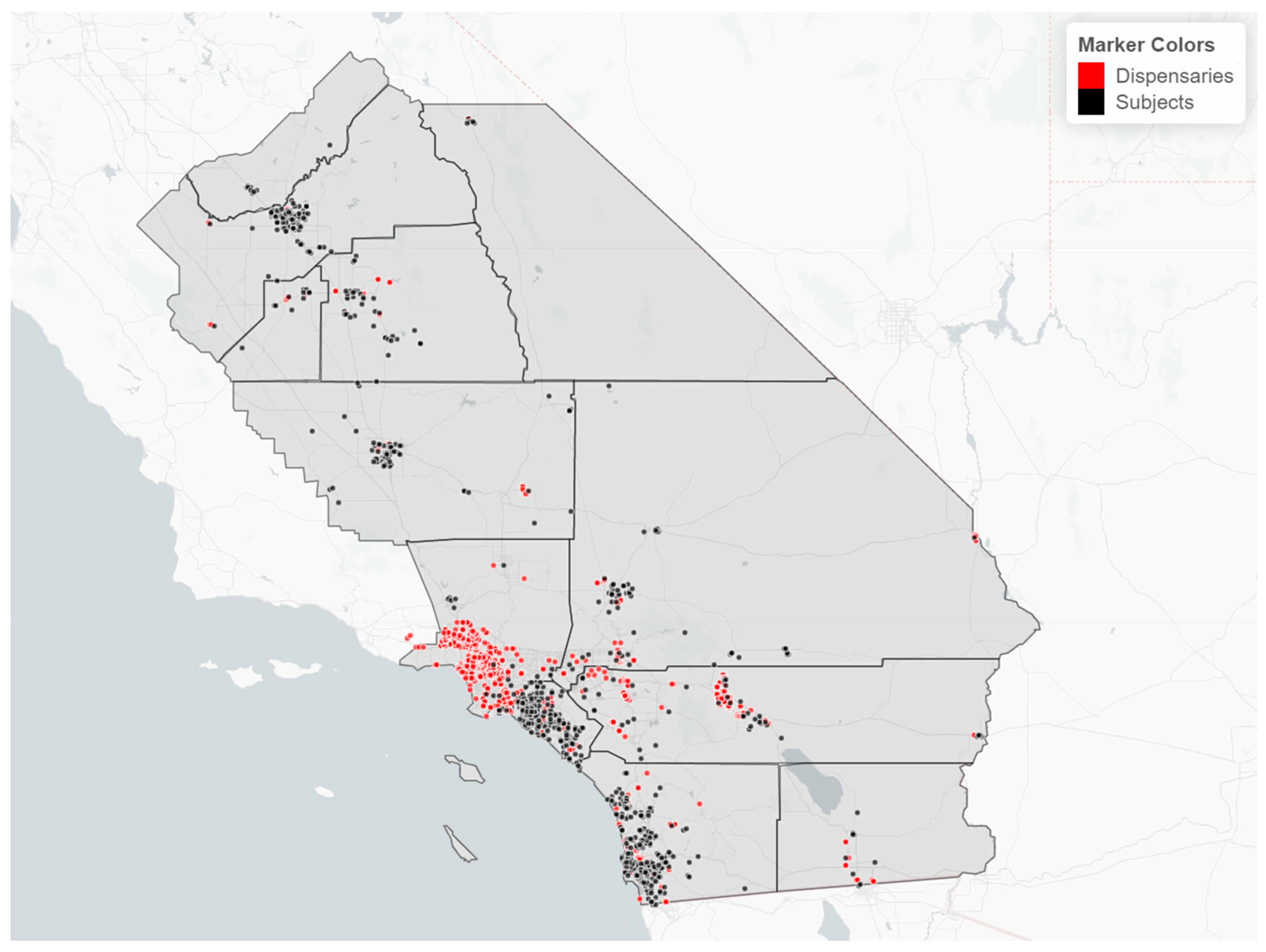
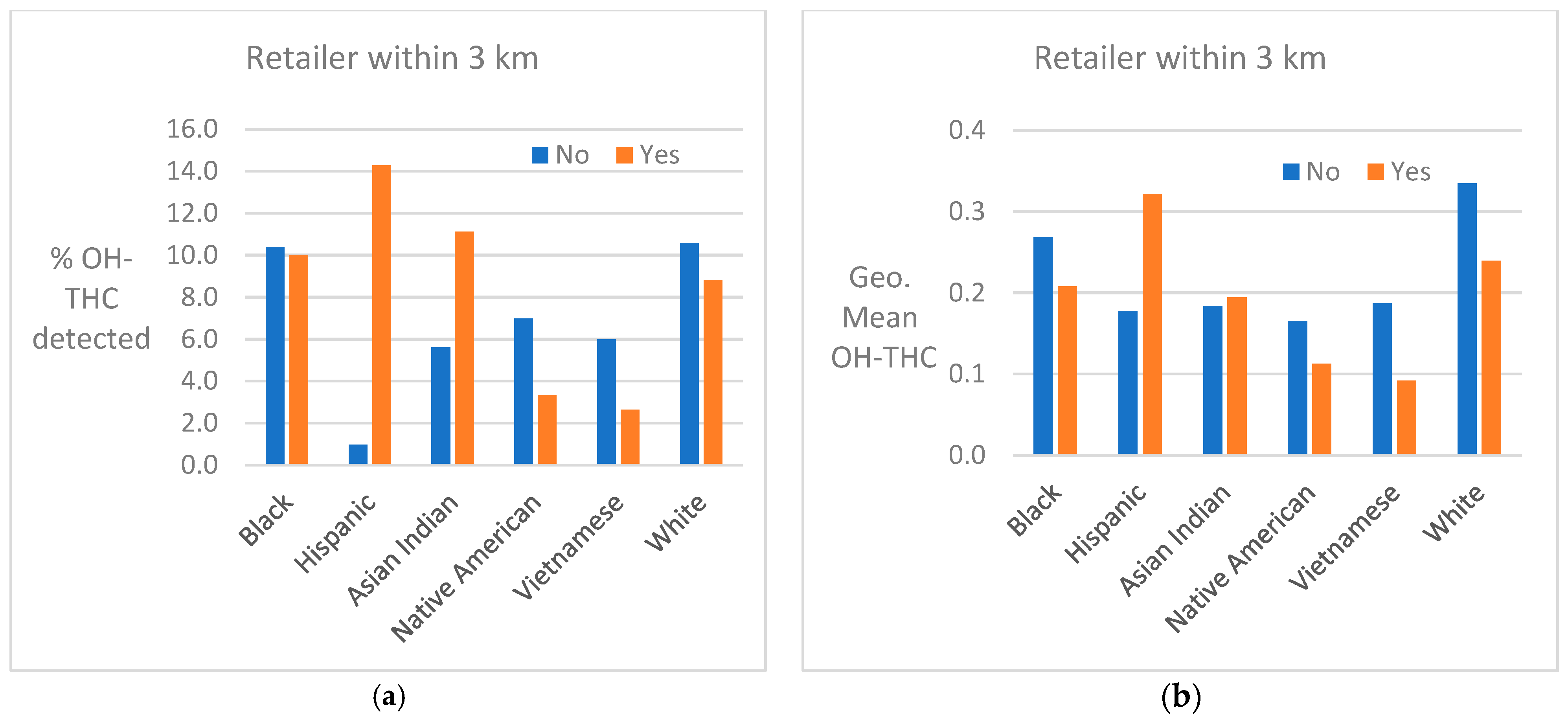
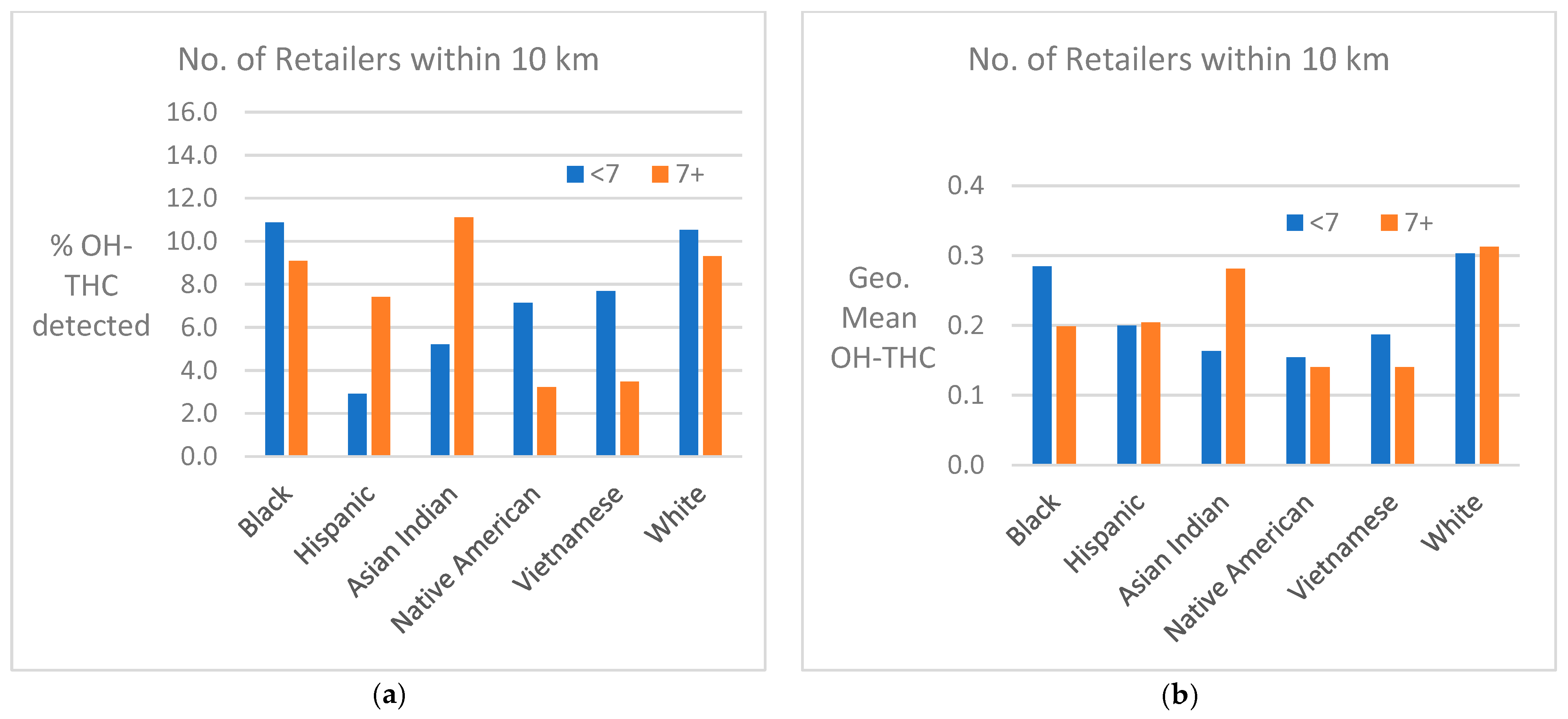
| Race/Ethnicity Group | ||||||
|---|---|---|---|---|---|---|
| Characteristic (Total N = 925) | Black (n = 161) | Hispanic (n = 147) | Asian Indian (n = 156) | Native American (n = 136) | Vietnamese (n = 164) | White (n = 161) |
| Age at blood collection (years) 1 | ||||||
| <21 | 10.6 | 10.2 | 0.0 | 12.5 | 1.2 | 4.4 |
| 21–27 | 38.5 | 34.0 | 9.6 | 33.1 | 7.9 | 19.3 |
| 28–34 | 34.8 | 34.7 | 50.6 | 36.0 | 45.1 | 36.7 |
| ≥35 | 16.2 | 21.1 | 39.7 | 18.4 | 45.7 | 39.8 |
| Medicaid insurance coverage (%) 1 | 34.8 | 43.5 | 16.0 | 20.6 | 16.5 | 19.3 |
| County of residence (%) 1,2 | ||||||
| Fresno | 18.0 | 14.3 | 18.6 | 5.9 | 1.8 | 5.0 |
| Imperial | 1.2 | 4.8 | 0.0 | 0.0 | 0.0 | 0.0 |
| Inyo | 0.0 | 0.0 | 0.0 | 4.4 | 0.0 | 0.0 |
| Kern | 10.6 | 7.5 | 14.1 | 11.1 | 0.0 | 3.1 |
| Kings | 0.6 | 2.0 | 0.6 | 3.0 | 0.0 | 3.1 |
| Los Angeles | 1.9 | 3.4 | 1.3 | 2.2 | 3.7 | 1.9 |
| Madera | 0.0 | 4.1 | 0.6 | 1.5 | 0.0 | 0.0 |
| Merced | 0.0 | 0.0 | 0.6 | 0.0 | 0.0 | 0.0 |
| Orange | 6.2 | 12.9 | 28.9 | 17.0 | 70.7 | 29.2 |
| Riverside | 5.0 | 6.8 | 0.0 | 6.7 | 3.1 | 6.2 |
| San Bernardino | 21.7 | 4.1 | 1.9 | 11.1 | 0.0 | 8.1 |
| San Diego | 32.9 | 27.9 | 33.3 | 30.4 | 20.7 | 38.5 |
| Tulare | 1.9 | 12.2 | 0.0 | 6.7 | 0.0 | 5.0 |
| ≥20% below poverty level (%) 1 | 45.3 | 34.0 | 8.3 | 29.4 | 12.2 | 16.2 |
| ≥6% unemployed (%) 1 | 67.7 | 64.0 | 34.0 | 54.4 | 32.9 | 39.8 |
| Cannabis retailer ≤ 3 km from residence (%) 2,3 | 22.7 | 22.1 | 21.1 | 24.4 | 21.7 | 27.5 |
| Number of cannabis retailers within ≤10 km radius (mean) 1,2 | 6.4 | 6.0 | 5.7 | 5.8 | 12.6 | 7.2 |
| Race/Ethnicity Group | ||||||
| Black | Hispanic | Asian Indian | Native American | Vietnamese | White | |
| ||||||
| Categorical exposure | ||||||
| No. of subjects (total N = 925) | 161 | 149 | 158 | 136 | 165 | 163 |
| Cotinine ≥ 0.1 ng/mL (%, 95% CI) | 69.6 (62.4, 76.4) | 48.3 (40.1, 56.5) | 50.6 (42.7, 58.6) | 60.3 (52.0, 68.6) | 44.5 (36.8, 52.2) | 53.4 (45.6, 61.2) |
| Smoker 1 (%, 95% CI) | 16.1 (10.4, 21.9) | 2.0 (0.0, 4.4) | 1.3 (0.0, 3.1) | 9.6 (4.6, 14.6) | 0.6 (0.0, 1.8) | 7.5 (3.4, 11.6) |
| ETS, nonsmokers with cotinine ≥0.1 ng/mL 2 (%, 95% CI) | 53.4 (45.6, 61.2) | 46.3 (38.1, 54.4) | 49.4 (41.4, 57.3) | 50.7 (42.2, 59.2) | 43.9 (36.2, 51.6) | 46.0 (38.2, 53.7) |
| Continuous exposure | ||||||
| No. of nonsmoking subjects (total N = 826) | 128 | 139 | 147 | 113 | 157 | 142 |
| Cotinine, ng/mL (geometric mean, 95% CI) 3 | 0.153 (0.121, 0.194) | 0.090 (0.080, 0.103) | 0.085 (0.074, 0.097) | 0.114 (0.092, 0.138) | 0.085 (0.075, 0.097) | 0.093 (0.078, 0.111) |
| Cotinine, ng/mL (IQR 25–75th percentile) | 0.075–0.240 | 0.064–0.140 | 0.060–0.146 | 0.071–0.183 | 0.054–0.138 | 0.056–0.157 |
| Race/Ethnicity Group | ||||||
| Black | Hispanic | Asian Indian | Native American | Vietnamese | White | |
| ||||||
| Categorical exposure | ||||||
| No. of subjects (total N = 677) | 112 | 112 | 117 | 98 | 118 | 120 |
| OH-THC ≥ 1.0 ng/mL (%, 95% CI) | 12.5 (6.3, 18.7) | 4.5 (0.6, 8.3) | 7.7 (2.8, 12.6) | 7.1 (2.0, 12.3) | 5.9 (1.6, 10.3) | 11.7 (5.8, 17.5) |
| Continuous exposure | ||||||
| No. of subjects with OH-THC values >0 ng/mL (total = 397) | 76 | 58 | 76 | 51 | 62 | 74 |
| OH-THC, ng/mL (geometric mean, 95% CI) 3 | 0.255 (0.186, 0.350) | 0.201 (0.146, 0.277) | 0.186 (0.131, 0.264) | 0.150 (0.088, 0.256) | 0.156 (0.105, 0.233) | 0.306 (0.223, 0.419) |
| OH-THC, ng/mL (IQR 25–75th percentile) | 0.100–0.700 | 0.070–0.480 | 0.090–0.480 | 0.050–0.510 | 0.707–0.470 | 0.170–0.750 |
| Race/Ethnicity Group | ||||||
| Black | Hispanic | Asian Indian | Native American | Vietnamese | White | |
| ||||||
| Categorical exposures | ||||||
| No. of subjects (total N = 677) | 112 | 112 | 117 | 98 | 118 | 120 |
| OH-THC (≥1 ng/mL): -In smokers 1 (%, 95% CI) | 31.8 (10.7, 53.0) | N/A | N/A | 8.3 (0.0, 26.7) | N/A | 50.0 (5.3, 94.7) |
| -In ETS-exposed nonsmokers 2 (%, 95% CI) | 8.5 (1.2, 15.8) | 7.1 (0.2, 14.1) | 7.7 (0.2, 15.2) | 9.1 (1.2, 16.9) | 8.2 (0.2, 16.1) | 13.7 (4.0, 23.5) |
| -In nondetects, cotinine < 0.1 ng/mL (%, 95% CI) | 6.5 (0.0, 15.6) | 1.9 (0.0, 5.7) | 6.3 (0.2, 12.5) | 3.2 (0.0, 9.8) | 4.3 (0.0, 9.3) | 4.9 (0.0, 10.5) |
| Cotinine (≥0.1 ng/mL): | ||||||
| -In OH-THC-detected subjects (%, 95% CI) | 85.7 (64.7, 100) | 80.0 (24.5, 100) | 55.6 (15.0, 96.1) | 85.7 (50.8, 100) | 57.1 (7.7, 100) | 78.6 (54.0, 100) |
| -In nondetects, OH-THC < 1 ng/mL (%, 95% CI) | 70.4 (61.2, 79.6) | 51.4 (41.8, 61.0) | 45.4 (35.8, 54.9) | 67.0 (57.2, 76.9) | 40.5 (31.3, 49.8) | 45.3 (35.7, 54.9) |
| Continuous exposures | ||||||
| No. of subjects (total N = 384) 3 | 72 | 56 | 74 | 51 | 60 | 71 |
| Pearson correlation coefficient, cotinine and OH-THC (p-value) | 0.25 (0.03) | −0.10 (0.45) | −0.05 (0.64) | −0.04 (0.78) | 0.33 (0.01) | 0.42 (0.00) |
Disclaimer/Publisher’s Note: The statements, opinions and data contained in all publications are solely those of the individual author(s) and contributor(s) and not of MDPI and/or the editor(s). MDPI and/or the editor(s) disclaim responsibility for any injury to people or property resulting from any ideas, methods, instructions or products referred to in the content. |
© 2023 by the authors. Licensee MDPI, Basel, Switzerland. This article is an open access article distributed under the terms and conditions of the Creative Commons Attribution (CC BY) license (https://creativecommons.org/licenses/by/4.0/).
Share and Cite
Kharrazi, M.; Berger, K.; Pearl, M.; Li, Y.; DeGuzman, J.; Behniwal, P.; Morse, A.; Moskalenko, I.; Williams, R.J.; She, J. Prenatal Exposure to Tobacco and Cannabis in Six Race/Ethnicity Groups during the First Three Years after Legalization of Cannabis for Recreational Use in California. Int. J. Environ. Res. Public Health 2024, 21, 11. https://doi.org/10.3390/ijerph21010011
Kharrazi M, Berger K, Pearl M, Li Y, DeGuzman J, Behniwal P, Morse A, Moskalenko I, Williams RJ, She J. Prenatal Exposure to Tobacco and Cannabis in Six Race/Ethnicity Groups during the First Three Years after Legalization of Cannabis for Recreational Use in California. International Journal of Environmental Research and Public Health. 2024; 21(1):11. https://doi.org/10.3390/ijerph21010011
Chicago/Turabian StyleKharrazi, Martin, Kimberly Berger, Michelle Pearl, Ying Li, Josephine DeGuzman, Paramjit Behniwal, Allison Morse, Ilya Moskalenko, Rebecca J. Williams, and Jianwen She. 2024. "Prenatal Exposure to Tobacco and Cannabis in Six Race/Ethnicity Groups during the First Three Years after Legalization of Cannabis for Recreational Use in California" International Journal of Environmental Research and Public Health 21, no. 1: 11. https://doi.org/10.3390/ijerph21010011
APA StyleKharrazi, M., Berger, K., Pearl, M., Li, Y., DeGuzman, J., Behniwal, P., Morse, A., Moskalenko, I., Williams, R. J., & She, J. (2024). Prenatal Exposure to Tobacco and Cannabis in Six Race/Ethnicity Groups during the First Three Years after Legalization of Cannabis for Recreational Use in California. International Journal of Environmental Research and Public Health, 21(1), 11. https://doi.org/10.3390/ijerph21010011






